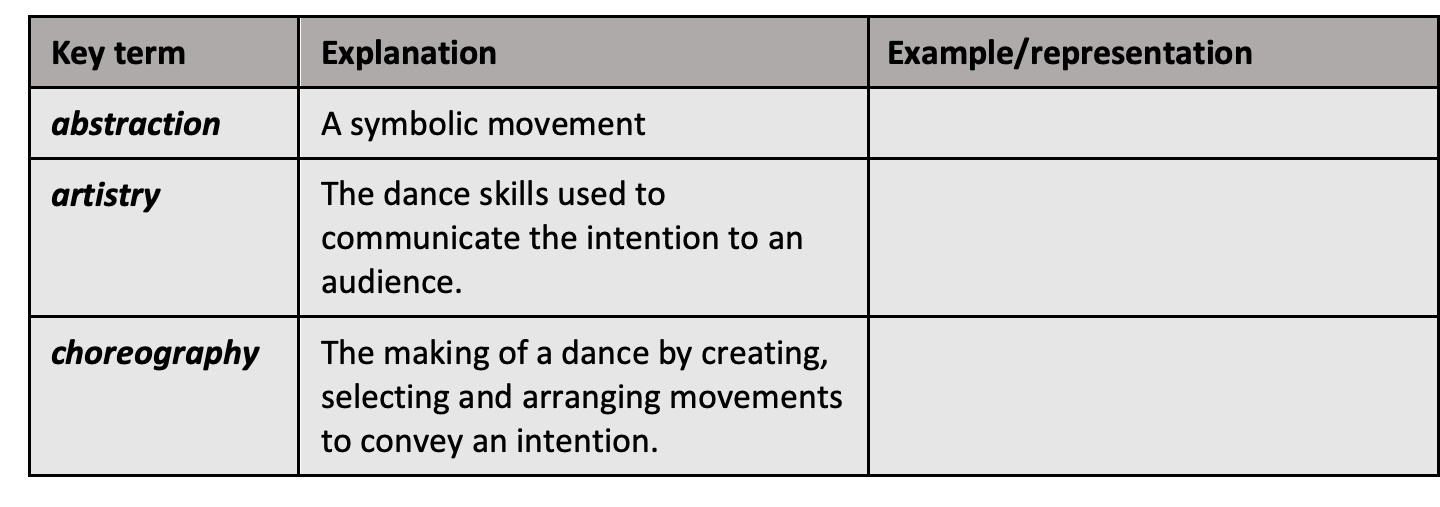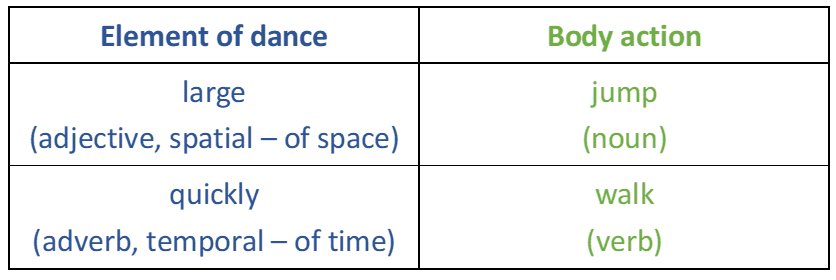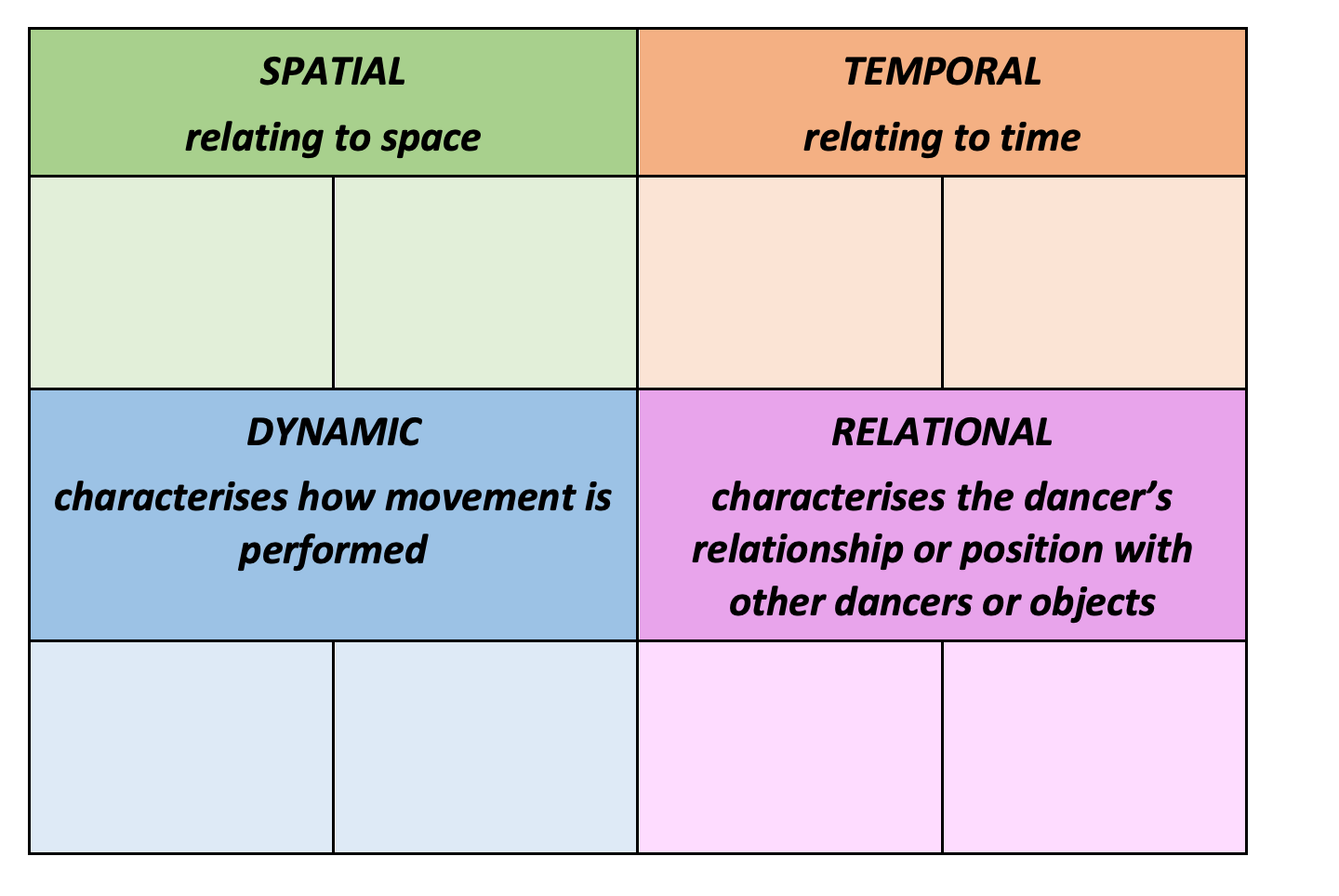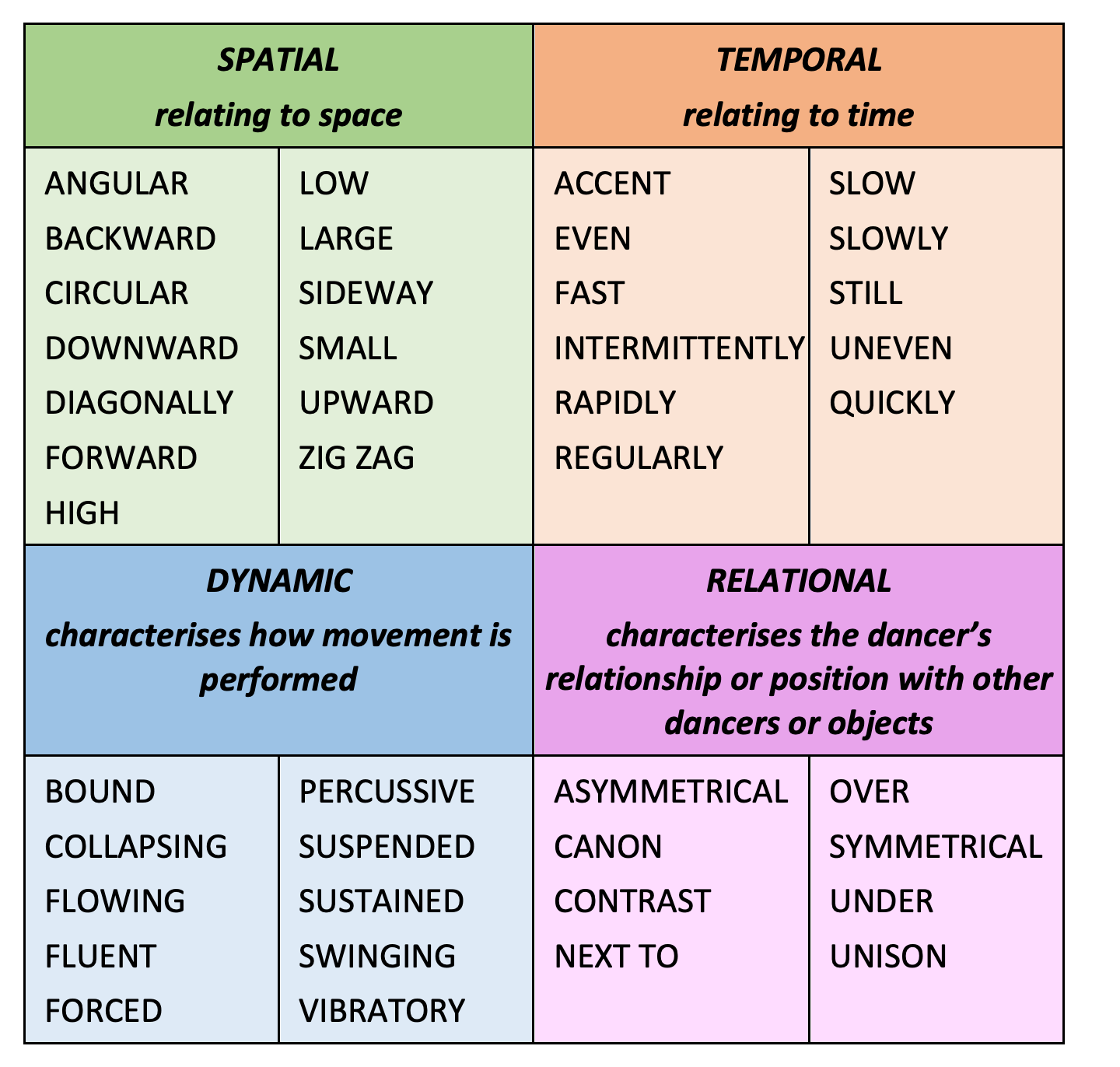In Dance, students must learn specific vocabulary. This vocabulary is used to discuss, interpret, and apply key concepts in spoken, written and performative components of Dance. Introducing and modelling technical vocabulary in Dance should incorporate physical, spatial, and gestural elements.
Creating glossaries
Glossaries are useful resources for students as they develop and revise Dance vocabulary. Students' multimodal literacy is developed as they:
- identify key terms In Dance
- define and explain the key terms
- link the key terms and Dance concepts to movement and visual representations and examples.
- Students are presented with a table showing the 'Key Terms' vocabulary. The 'Explanation' and 'Example/representation' columns should be blank prior to the students' completion of the activity.
(Depending on the class cohort and their prior knowledge and experience in Dance, the table may contain more or less information prior to the students' completion of all columns, for example, the teacher may include some of the explanations or examples initially.)

A more detailed list of Dance terminology can be found in the worksheet on Fuse.
- The teacher asks students to form groups of three. Following the teacher’s prompts, the groups are asked to:
- Identify and highlight familiar words in the 'Key terms' column.
- Discuss the contexts in which they have seen or used these terms previously, for example, 'symmetrical' in Mathematics or Art.
- Suggest what the words in the 'Key terms' column might indicate when applied in Dance.
- The teacher presents explanations in jumbled order. Student groups discuss the matching of explanations to each of the ‘key terms’ and complete the second column in the table. (As an alternative, sections of the ‘Key terms’ table may be allocated to different groups to complete, for example, one group might be responsible for the ‘Group structures’ vocabulary.)
- The teacher and the students discuss the possible uses and effects of each of the elements in Dance by viewing examples, either on video or via performance and movement in the classroom space. Where relevant, examples are noted in the ‘Example/representation’ column.
- The teacher discusses with the students how more specific terminology may vary across genre, culture, and contexts of dance. The following examples are used to illustrate this point.
- A ‘fan kick’ in jazz dance refers to a kick in which the working leg makes a sweeping arc in from of the body.
- ‘Popping’ and ‘locking’ in Hip Hop dance refer to styles of street dance.
- A ‘grande ronde de jambe battement’ in ballet involves a large circular movement of the working leg moving outward from the body and in again.
- Referring to the latter example, the teacher asks the students what language is used for most of the terminology of ballet. The teacher explains that terminology is often associated with the culture or context in which the dance style originated or was formalised.
- The teacher and students initiate and discuss other terminology from different dance styles.
- Where possible, the teacher encourages students to demonstrate the terms through movement.
Connecting verbal language and movement: Guided improvisation
Total Physical Response (TPR) is a language learning method developed by James Asher (1966) in which students respond physically to language cues. Through physical action, TPR develops listening and speaking skills in connection to motor skills and kinaesthetic learning.
Building and modelling the relationship between language and movement supports students in Dance to:
- express ideas
- respond to and interpret dance works
- develop and articulate dance practices.
The following strategy involves the embodying of elements of dance through guided improvisation. Students draw on their knowledge of Dance terminology previously developed through activities including the creation of glossaries (see above). Students are encouraged to move around a large space as the teacher delivers prompts and commands.
- The teacher explains that the activity will involve students listening and responding through movement to combinations of nouns, verbs, adjectives, and adverbs related to the elements of dance.
- The teacher draws on examples such as those below and highlights examples of nouns, verbs, adjectives, and adverbs.
- The teacher models a command using words from the word bank table (below), for example, 'a large jump' or 'walk quickly.' Students move in response to the command.

- The teacher directs the students to walk around the room swiftly.
- When the teacher commands, students ‘freeze’ and then respond spontaneously in movement to the teacher’s combination of terms from the word bank.
- After several rounds, the teacher and students discuss the different interpretations of the commands.
Curriculum links for the above example:
VCADAE034,
VCADAD036,
VCADAP037,
VCADAE041,
VCADAR045.
Expanding the Dance word bank
As students become more familiar with dance terminology and practice, teachers can extend students' understanding of vocabulary by having them expand their dance word banks.
To do this:
- The teacher asks students to use their prior knowledge to define the terms:
- spatial
- temporal
- dynamic
- relational.
- The teacher and students share and clarify definitions:
- spatial – of space
- temporal – of time
- dynamic – type of movement
- relational – the dancer's relationship to other dancers, time, space, music
- The teacher provides students with a graphic organiser, such as the one below, for students to write down their jointly constructed definitions.

- The teacher provides examples of adjectives, adverbs and prepositions related to each of the headings in the table, for example:
- Adjectives – ‘low,’ ‘circular’
- Adverbs – ‘regularly,’ ‘quickly’
- Prepositions – ‘next to,’ ‘over.’
- The teacher supports students to classify the examples under each of the headings in the table.
- Teacher asks students to form small groups of 3 or 4. Student groups discuss examples related to each of the four classifications and note these in their tables. (As an alternative, each group may be given a different heading.)
- Student groups share their examples and add to their tables (see examples below).
- Teacher leads students in identifying examples of adjectives, adverbs or prepositions.

- The teacher combines terms from the word bank to create full sentences, for example, ‘The high-level movement in a forward direction was performed quickly to denote the desire of flying in the sky.’
- The teacher explains that ‘desire of flying in the sky’ is an abstraction. In Dance, an abstraction is a symbolic movement.
- The teacher and students brainstorm further examples of abstraction and use the word bank to jointly construct full sentences.
- In small groups, the students are given time to draw on the word bank and their constructed sentences to create and perform movements and gestures.
Curriculum links to the above example:
VCADAE033,
VCADAE034,
VCADAD036,
VCADAP037,
VCADAE041,
VCADAR045.